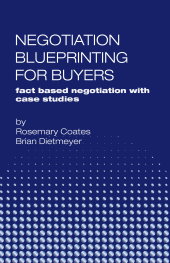 If we know where and what most of the traps are in business negotiation, and we know they are fear driven, why do we keep reacting in the same way? There are two key tactics used by 97% of buyers - mention an alternative and leverage it to start the bargaining. This then creates three key problems: commoditiztion pressure, price pressure and selling "value" and then falling back to negotiating price. Value is a word we hear a lot these days. It's supposed to denote something worthwhile, significant, tangible and durable.
If we know where and what most of the traps are in business negotiation, and we know they are fear driven, why do we keep reacting in the same way? There are two key tactics used by 97% of buyers - mention an alternative and leverage it to start the bargaining. This then creates three key problems: commoditiztion pressure, price pressure and selling "value" and then falling back to negotiating price. Value is a word we hear a lot these days. It's supposed to denote something worthwhile, significant, tangible and durable.
As modern-day salespeople, we are taught how to sell value. And, according to our research with the Strategic Account Management Association (SAMA), we are doing better at selling it more consistently. We recognize a customer's problem, work hard to find a solution and are trying to sell value upstream. But let's face it, most salespeople have a hard time selling value, in large part because they have only a vague idea of what it really is in a given deal. Sure, most marketing departments have formal value propositions, but true value in any given deal is simply a description of how one side can advance the customer's business goals in a way the competition cannot. So on the back end of a deal, when our goals become cloudy, if we can't prove the value we tried to sell earlier, we default to negotiating price, undoing any positional or price advantage we'd gained up front. It's the classic bait and switch, except in this scam both sides lose. It's not intentional and, thankfully, it is preventable.
Value actually shifts: from day to day, from deal to deal, from product to product and from company to company. As the customer looks at his alternatives and then at your proposal, value arises from the places where your solution meets his needs incrementally better. And this process of becoming a geeky street fighter teaches you to find, distill and absorb a whole new batch of research for any particular deal so you can find that value and meet this customer's needs in this deal.
In fact, value is invaluable because when you can prove it, you can often get a price premium. Creating true value - value that customers will pay for - without sacrificing price or succumbing to the pressure to commoditize on the back end is the name of today's game.





